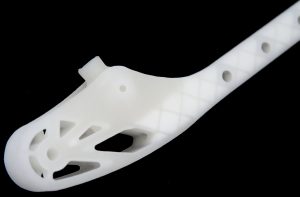Orthotic Device Optimisation
Summary | Design optimisation of orthotic device results in 40% weight saving
The problem | Ricoh 3D teamed up with medical professionals at The Orthotic Research & Locomotor Assessment Unit (ORLAU) to series manufacture a lever-hinge mechanism which assists patients with fitting and removing their ankle-foot orthotic.
Our engineers then set about reducing the part’s weight to further improve comfort and lower the price for this extremely cost-sensitive industry, but without compromising the part strength required to lever the device away from the patient’s leg.

The solution | An ankle CCD (Contracture Correction Device) is used to help treat patients with muscle and soft tissue tightness around the ankle and calf muscles.
Patients can often find a orthotic device difficult to put on and remove on a regular basis as part of their rehabilitation. The orthotic research team at The Robert Jones and Agnes Hunt Orthopaedic Hospital developed a clever lever-hinge mechanism which opens up the CCD to improve ease-of-use, while also assisting the user in applying the stretching force.
This mechanism was first manufactured through conventional machining and assembly but, after consultation with Ricoh 3D, it was clear that 3D printing offered a better option by printing the ball joint feature in situ, removing the need for assembly. The finished product was lightweight and robust yet flexible and tested to over 3,000 cycles, with an estimated lifespan of more than five years.
The 3D printed aid received positive feedback from users, but the Ricoh 3D team knew that further benefits, such as lattice structures and trapped powder removal, were possible using design optimisation software, while retaining enough strength for the intended application. As the device is produced in low volumes, reducing the overall cost through a lighter weight part with less powder usage was key.
First, Finite Element Analysis (FEA) was carried out to determine the current Factor of Safety and ascertain how much material could be removed and where. There were no internal structure constraints, but the team had to allow for unsintered powder to be removed to make the part lighter and therefore reduce the cost of sintering time.

Next, Generative Design (GD) improvements were created using intelligent software to remove material. Lattice structures were introduced and trapped powder was removed to lightweight the lever by 40%, from 48.3g to 29.2g, and achieve a 15% cost reduction
A series of destructive load tests were carried out to confirm the newly-optimised part performed and was as strong as the original design. The results proved that, like the original, the part could not be destructed and returned to its original shape after testing.
The newly-optimised, more cost effective, part met all of the client’s bend and quality requirements, while the innovative and futuristic design also appealed to end users.
The lever-hinge mechanism system is now in full production and helping to make life easier for patients thanks to 3D technology.
Ricoh 3D is looking forward to working with ORLAU on future healthcare innovations, as the medical sector continues to realise the benefits of 3D printing in improving and customising treatment.
